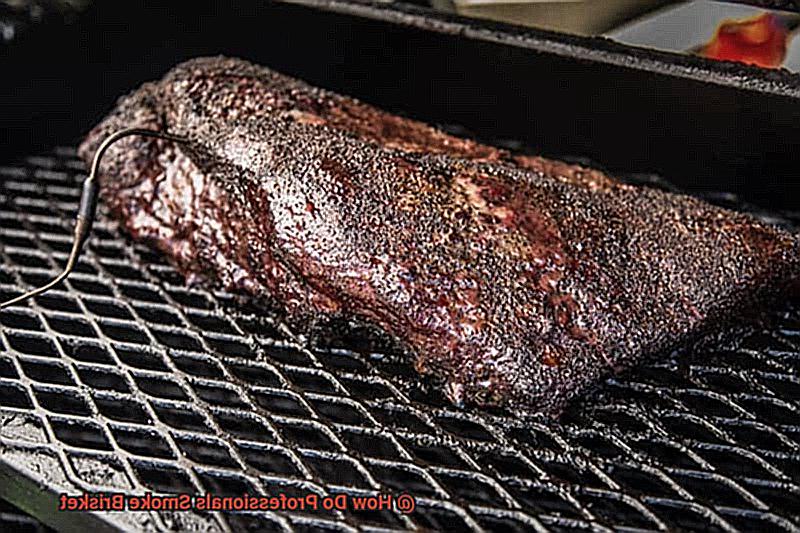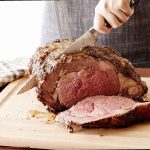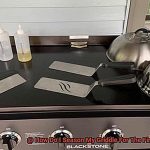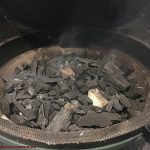Do you salivate at the thought of a perfectly smoked brisket? Are you ready to up your smoking game and learn from the pros? Then, buckle up because we’re about to take you on a journey to brisket heaven.
Smoking a brisket can be daunting, but with some expert guidance, you’ll be able to impress your friends and family with mouth-watering, fall-off-the-bone meat. So, how do professionals smoke brisket? Let’s break it down.
First things first, choosing the right cut of meat is crucial. Prime-grade brisket is the gold standard for professional smokers because it has the perfect balance of fat and meat. This ensures that your brisket will come out tender and juicy every time.
Once you’ve got your cut of meat sorted, it’s time to season it up. The best rubs are often a combination of salt, black pepper, paprika, garlic powder, and onion powder. But don’t be afraid to experiment with different flavors and spices to find your perfect blend.
Now comes the fun part – smoking. Professional smokers use a combination of wood and charcoal to get that classic smoky flavor. Maintaining consistent temperature control is key here, so investing in a smoker or temperature probe is highly recommended.
By following these tips from the pros, you’ll be well on your way to smoking a restaurant-quality brisket in no time. So fire up that smoker and get ready for some serious flavor.
Contents
Choosing the Right Cut of Brisket
Smoking a brisket is an art form that requires a lot of patience and skill, and choosing the right cut of meat is crucial to achieving a perfectly cooked and flavorful end result. The two main cuts of brisket to choose from are the point and the flat.
The point, also known as the deckle, is the fattier end of the brisket and has more marbling throughout the meat. This cut is ideal for those who prefer a richer and more flavorful meat. On the other hand, the flat is leaner and has a more uniform shape. It has less fat and is a popular choice for those who prefer a healthier option.
If you’re new to smoking brisket or have limited space on your smoker, you may want to start with just one cut at a time. However, many professional pitmasters prefer to use a full packer brisket, which contains both the point and the flat. This allows for a balance of flavor and texture in the final product.
When selecting a brisket, look for one that has a good amount of marbling and a thick, even layer of fat on top. This will help keep the meat moist during the long smoking process. Avoid briskets that are too lean or have large areas of fat trimmed off.
It’s also important to consider the size of the brisket. A smaller brisket may be easier to manage on your smoker, but it will also cook faster and may dry out if not monitored closely. A larger brisket will take longer to smoke but will result in more servings and can be more forgiving in terms of moisture retention.
Once you’ve selected your brisket, it’s time to prepare your smoker. Many professionals use a traditional offset smoker filled with wood chips or chunks. Before placing the brisket in the smoker, apply a dry rub or marinade to enhance the flavor and create a crispy bark on the outside of the meat.
Smoking a brisket can take anywhere from 10-20 hours or more depending on the cut and size. Professionals aim for an internal temperature of 195-205 degrees Fahrenheit before removing the brisket from the smoker.
To ensure that your brisket is cooked to perfection, it’s important to monitor the temperature and smoke levels throughout the cooking process. Use a meat thermometer to check the internal temperature of the meat and adjust the heat and smoke levels as needed.
Preparing the Smoker
If you’re ready to smoke a brisket like a professional, the first step is always preparing your smoker. This crucial process ensures that your meat is cooked to perfection, with that perfect smoky flavor and irresistible tenderness.
To start, it’s important to clean your smoker thoroughly. Scrub down the grates with hot soapy water and rinse them thoroughly. This will ensure that there are no leftover bits from your last cookout that could affect the flavor of your brisket.
Next, fill up your smoker with the appropriate fuel source. If you’re using a charcoal smoker, use lump charcoal or briquettes and light them up using a chimney starter. For gas and electric smokers, make sure the propane tank is full or the smoker is plugged in and working properly.
Once your fuel source is ready, adjust the temperature of your smoker according to your recipe. For most brisket recipes, a low and slow cooking method is ideal, so aim for a temperature between 225-250°F.
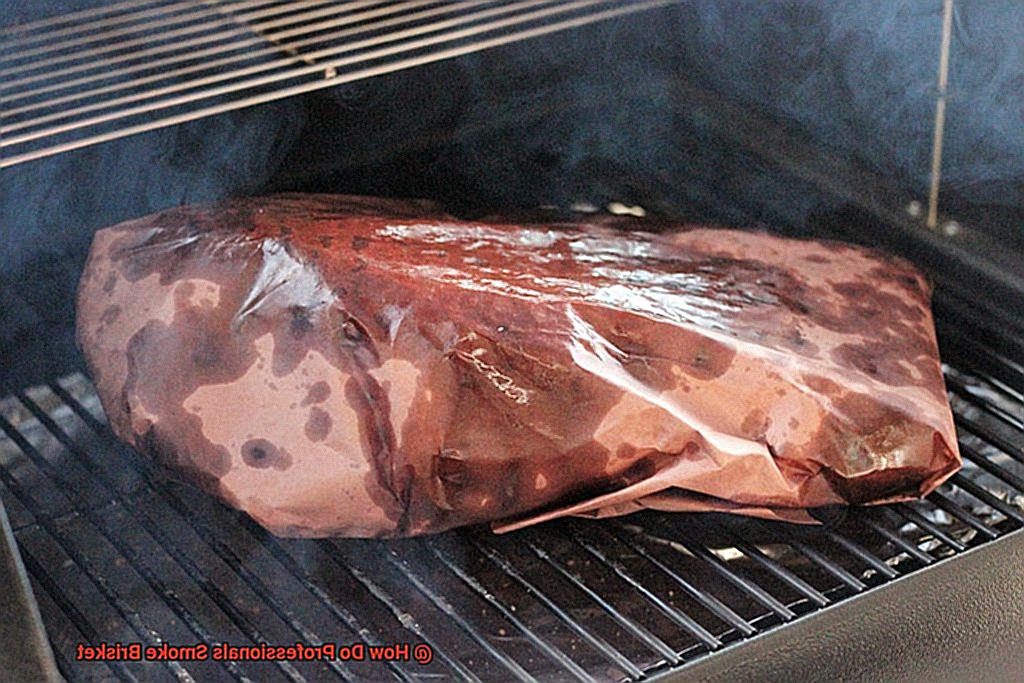
Now it’s time to add some wood chips or chunks to the smoker box or directly onto the coals. Hickory, oak, and mesquite are popular choices for smoking brisket, but don’t be afraid to experiment with different wood flavors to find what works best for you.
Finally, place your brisket on the grates of the smoker, fat side up, and close the lid. Resist the urge to peek inside too often as this will release heat and smoke, which can affect the cooking time and flavor of your brisket.
In summary, here’s a quick checklist for preparing your smoker:
- Clean the grates thoroughly.
- Fill up your smoker with the appropriate fuel source.
- Adjust the temperature according to your recipe.
- Add wood chips or chunks.
- Place your brisket on the grates.
- Avoid peeking inside too often.
Applying a Dry Rub or Marinade
Smoking a brisket is an art form, and the secret to achieving the perfect flavor lies in applying a dry rub or marinade. But what exactly are these two methods, and how do you use them to make your brisket taste like it was made by a pro? As an expert in this subject, I’m here to guide you through the process.
Let’s start with the basics. A dry rub is a mixture of spices and seasonings that are rubbed onto the surface of the meat prior to smoking. This method provides a flavorful crust on the outside of the brisket, while keeping the meat juicy and tender on the inside. On the other hand, a marinade is a liquid mixture that the brisket is soaked in for a period of time before being smoked. This method infuses the meat with flavor from all sides, resulting in a juicy and savory brisket.
Professional smokers have their own signature dry rubs or marinades that they use to impart a unique flavor profile to their brisket. However, there are some common ingredients that are often included in these mixtures. For example, a dry rub may contain a combination of salt, black pepper, paprika, garlic powder, onion powder, and brown sugar. A marinade may include ingredients such as soy sauce, Worcestershire sauce, vinegar, and honey.
One important thing to keep in mind is that applying too much dry rub or marinade can actually overpower the flavor of the meat. Professional smokers often recommend using just enough to create a flavorful crust on the outside of the brisket without overwhelming the taste of the meat itself. So be sure to use these mixtures sparingly and with precision.
When applying a dry rub, it is best to coat the brisket evenly on all sides and allow it to sit for at least an hour before placing it in the smoker. This gives the spices time to penetrate into the meat for maximum flavor. For a marinade, it is recommended to soak the brisket for at least 8-12 hours in the refrigerator before smoking. This allows the meat to absorb the liquid and flavors thoroughly.
Placing the Brisket in the Smoker
Smoking a brisket is a delicate art form that requires attention to detail, and placing the brisket in the smoker is a crucial step that must be executed properly. The first step is to preheat the smoker to the ideal temperature range of 225-250°F. This temperature range allows for a slow cooking process that infuses the meat with flavor and tenderness.
Before placing the brisket in the smoker, it’s essential to trim off any excess fat and apply a dry rub or marinade. This step is critical because it helps to infuse the meat with flavor and also forms a mouth-watering crust on the outside of the brisket during cooking.
Once the smoker has reached the desired temperature, it’s time to position the brisket on the cooking grate with the fat side up. This positioning allows for the fat to melt and drip down into the meat, keeping it moist and flavorful. It’s like a juicy self-basting mechanism.
It’s important to note that smoking a brisket can take several hours, so monitoring both the smoker and meat temperature regularly is crucial. A digital thermometer can be used to check the internal temperature of the brisket, which should be around 195-205°F for optimal tenderness.
To recap, here are the steps to placing a brisket in a smoker:
- Preheat your smoker to 225-250°F
- Trim off excess fat and apply your dry rub or marinade
- Position your brisket on the cooking grate with the fat side up
- Monitor both smoker and meat temperature regularly using a digital thermometer
Monitoring and Adjusting Temperature
Smoking brisket is an art form that requires precision, patience, and a whole lot of love. However, one of the most critical aspects of achieving that melt-in-your-mouth texture and signature smoky flavor is monitoring and adjusting the temperature throughout the smoking process.
Professionals use various tools to keep track of the temperature when smoking brisket. The meat thermometer is a popular tool used by professionals to track the internal temperature of the meat accurately. Inserting a meat thermometer into the thickest part of the brisket allows professionals to get an accurate reading and make adjustments as needed.
In addition to the meat thermometer, smoker thermometers are also essential tools in a professional smoker’s arsenal. These thermometers are installed in the smoker itself and provide real-time information about the temperature inside. This helps professionals make adjustments as needed to maintain a consistent temperature throughout the smoking process.
Maintaining a consistent temperature can be challenging when smoking brisket due to external factors such as wind, humidity, and air temperature. To combat this, professionals adjust the smoker’s vents, increase or decrease fuel usage, or add water to regulate temperature.
It’s important to note that different cuts of meat and cooking methods require different temperatures. Professionals consider factors such as meat thickness and desired level of doneness when determining the appropriate temperature for smoking.
Cooking Time for Brisket
Then let’s dive into the crucial factors that influence its cooking time, and learn how to achieve that mouth-watering, fall-off-the-bone texture and smoky flavor that we all crave.
Smoking a brisket is an art that requires patience, attention to detail, and a low and slow cooking approach. The cooking time for a brisket can vary depending on several factors such as the size of the cut, the type of smoker used, and the temperature at which it is smoked. However, the two primary factors that greatly influence cooking time are the size of the cut and the smoking temperature.
To achieve tender and juicy meat, professionals recommend smoking at an ideal temperature range between 225°F and 250°F. This allows the meat to cook slowly and evenly, allowing the connective tissues to break down gradually. As a result, you will get a tender and flavorful brisket. However, remember that every brisket is different; hence cooking time may vary slightly from one cut to another.
To ensure that your brisket is cooked to perfection, it’s essential to use a meat thermometer to monitor its internal temperature. The ideal internal temperature for a smoked brisket ranges between 195°F and 205°F. Once this temperature range is achieved, remove it from the smoker and give it at least 30 minutes to rest before slicing.
But how do you determine if your brisket is ready? To check for tenderness, professionals suggest using a probe thermometer to insert it into different sections of the meat. If it smoothly slides in and out with little resistance, your brisket is perfectly cooked.
Letting the Brisket Rest
Smoking a brisket is a delightful experience that requires attention to detail to achieve a perfectly cooked meal. One crucial step in achieving that perfection is letting the brisket rest. By allowing your brisket to rest, you will ensure a tender and juicy result that will leave your guests wanting more.
Why is letting the brisket rest important? Resting the brisket allows the juices to redistribute and settle back into the meat, resulting in a more flavorful and moist brisket. To make sure that your resting time is effective, consider these sub-topics:
- Temperature Control: Keeping the brisket covered with foil or butcher paper during resting helps retain heat and moisture, preventing the brisket from drying out. However, it’s important to monitor the internal temperature of the brisket during this time to ensure that it stays above 140°F, which is where bacteria can start to grow.
- Resting Time: Some professionals recommend letting the brisket rest for up to two hours, depending on the size of the cut. However, checking on your brisket periodically is crucial to ensure that it doesn’t overcook or dry out. A well-rested brisket will result in a mouth-watering experience.
- Slicing Technique: Once the resting period is over, it’s time to slice your perfectly smoked brisket. For tender and easy-to-eat pieces, it’s essential to slice against the grain. Don’t forget to save any leftover juices from the resting period to use as a delicious sauce or au jus.
Slicing the Brisket
Today, we’re going to delve into a crucial element of preparing a mouth-watering brisket: slicing. As an expert in the field, I cannot overemphasize how important it is to approach this process with care and precision. With that said, let’s dive into the juicy details.
Firstly, before you even think about slicing your brisket, it is essential to let it rest for at least 30 minutes. Allowing the meat to rest allows the flavorful juices to redistribute throughout the brisket, culminating in a sensational explosion of taste in every bite. Trust me; this step is well worth the wait.
Now that our brisket has had some time to relax, let’s talk about the right technique for slicing. To achieve succulent and easy-to-chew slices of meat, professionals know that cutting against the grain is key. Cutting with the grain can make the meat tough and chewy, which is undoubtedly not what we’re after.
To slice against the grain, examine the direction of muscle fibers in the meat, and make perpendicular cuts across them, typically about ¼ inch thick. Using a sharp knife is essential to achieve clean cuts and avoid tearing the meat.
Now, here’s a crucial tip: angle your cut slightly when slicing for larger slices with more surface area. This technique allows for more flavorful bark in every bite. However, be careful not to slice too thin as this can result in dry and overcooked meat.
Another critical factor when slicing brisket is separating the point and flat sections before slicing. The point has more fat and is usually used to make burnt ends or chopped brisket. The flat is leaner and makes for excellent sliced brisket.
In summary, slicing a brisket is an essential step in serving a delicious and visually appealing dish. Professionals slice against the grain, use a sharp knife for clean cuts, cut at a slight angle for optimal flavor and texture, and separate the point and flat if desired.
Conclusion
In the world of barbecue, smoking a brisket is considered an art form that requires patience, attention to detail, and a whole lot of love. Professional pitmasters have honed their craft over years of experience and experimentation, using a combination of techniques to achieve that perfect balance of smoky flavor and fall-off-the-bone tenderness.
The first step in smoking a brisket like a pro is choosing the right cut of meat. Prime-grade brisket is the gold standard for professional smokers due to its ideal ratio of fat to meat. Once you’ve got your meat sorted, it’s time to season it up with a dry rub or marinade that complements the natural flavor of the beef.
But seasoning alone won’t make your brisket stand out from the crowd. Preparing your smoker is essential for achieving that signature smoky flavor and irresistible texture. Consistent temperature control is key here, so investing in a high-quality smoker or temperature probe can make all the difference.
Throughout the smoking process, monitoring and adjusting the temperature is critical for achieving that melt-in-your-mouth texture. Professionals use various tools such as meat thermometers and smoker thermometers to keep track of things and make adjustments as needed.
Once your brisket has reached its ideal internal temperature, it’s important to let it rest before slicing. This allows the juices to redistribute throughout the meat, resulting in a more flavorful and moist end product. And when it comes time to slice your brisket, be sure to do so against the grain with a sharp knife at a slight angle – this will result in slices that are both succulent and easy-to-chew.
By following these expert tips from professionals on how to smoke brisket, you’ll be well on your way to impressing your friends and family with restaurant-quality meat every time you fire up your smoker.

